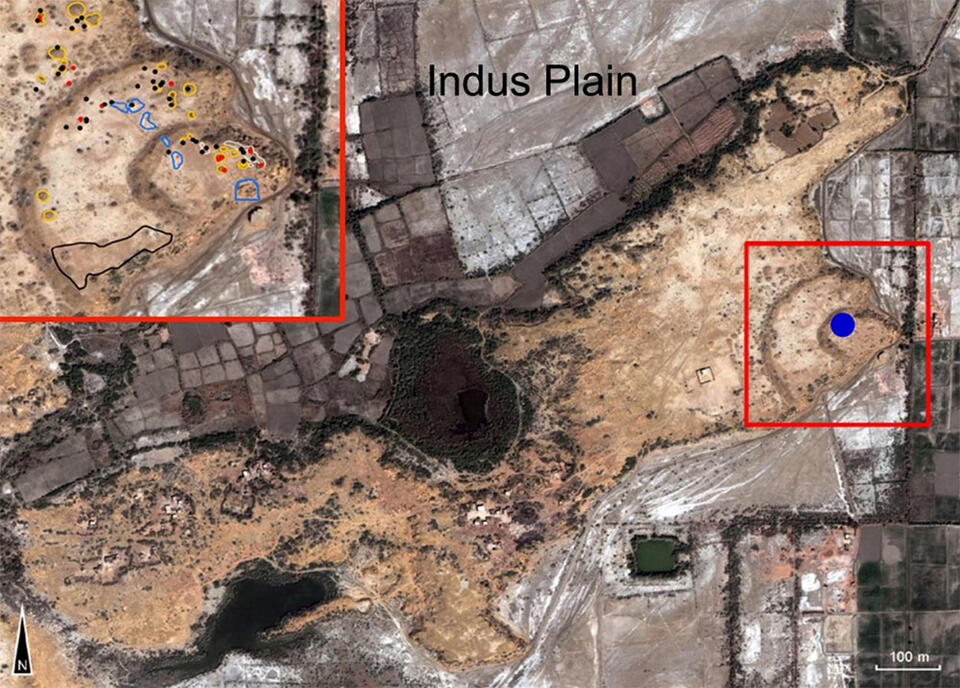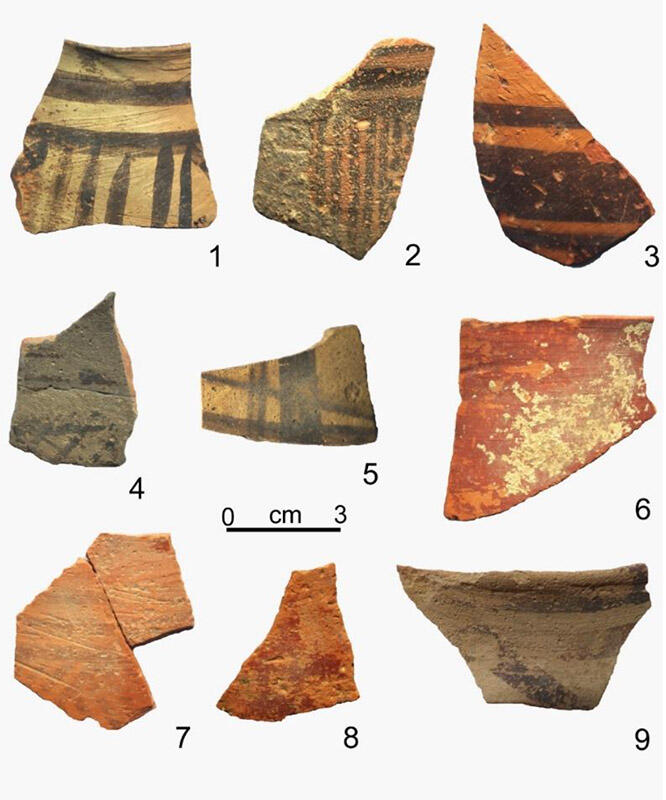Very little is known about the so-called "Amri Phase," as this author refers to an apparently pre-Indus civilization site in Sindh that dates to the 4th millennium BCE. He writes: "Our knowledge in this area is very poor. It relies almost exclusively on the ceramic assemblages retrieved during excavations carried out in the type site in the 1960s. Research currently underway in Lower Sindh has led to the discovery of more sites relevant for this problem. Many of them are located close to the ancient Arabian Sea coastline or on limestone terraces which used to be islands in the Chalcolithic times. They consist of shell middens, whose surface has yielded characteristic Amri Culture knapped stone assemblages," (p. 1).
Dr. Biagi, a veteran of pre-historic excavations and discoveries in Sindh which date back tens of thousands of years (see for example The Rohri Flint Quarries) expertly pulls together all that we know about the Amri Phase. Above all, the manifold issues of antecedent cultures that contributed to and were woven into what we call the ancient Indus civilization in the latter half of the 3rd millennium BCE are raised by this paper. When we look back across vast spans of time, it is too easy to forget that our vision is constrained by all that we don't know; the richness and differences that we see today between people and places are obscured. We may imagine that the Indus civilization was some a unified whole, but it was actually an composite of the many cultures and peoples that lived in the area and were more or less integrated in what was a consistent cultural, religious, and political "veneer," as some like to call this civilizational super-structure. Indeed, this paper stretches the geographical relationships involved, "The present paper analyses the Chalcolithic Amri Phase, its distribution in Sindh, the characteristics of the sites, their material cultural assemblages and radiocarbon chronology, and the way it can be related to other Chalcolithic phases of Balochistan to the west (Nal), and Punjab to the north (Hakra)," (p. 2).
Amri itself is little excavated, with only two of the mounds discovered by N.C. Majumdar in 1929 investigated by the pioneering Indian archaeologist (tragically murdered while excavating in SIndh in 1938), and then again by French archaeologist Jean-Marie Casal between 1959 and 1962. Recent work by the author and colleagues has located or confirmed the existence of other Amri-related sites elsewhere in Sindh based on radiocarbon dates and shell-middens, cermaics and mangrove shells. Small clues allow larger inferences to be made about the presence of Amri culture, both in the Tharro Hills (see Image 2 above), and around the Makli Hills necropolis: "The area around the ancient town of Kalan Kot, in the Makli Hills to the south of Thatta, is of unique importance. Six shell middens consisting of Telescopium telescopium fragments have been recorded around the southern walls of Kalan Kot (Fig. 6). Three of them have been dated to the first half of the 4th millennium BC (KKT-3, 4 and 5) (Fig. 7). They have been attributed to the Amri Phase, thanks to the presence of characteristic Amri type chert artefacts, despite the absence of other material culture and archaeozoological remains," (p. 6).
"To conclude," writes Dr. Biagi, "more work is necessary to understand the Chalcolithic Period of the Greater Indus Valley and the role it may have played in the formation of the Indus Civilisation. Our present knowledge is too limited and we are unable to suggest any conclusion. One of the interesting points advanced here concerns the knapped stone assemblages. They show very similar common traits in manufacturing technique. type of retouch and tool types, regardless of their geographic location, which are nevertheless different from those of the following Bronze Age. This is remarkable, because the subdivisions into phases has been established based on pottery analysis, while lithics have not been considered, at least in most cases. However, the situation seems to have slightly improved, especially in regard to the definition of the Amri Phase, thanks to the results of the surveys underway in Lower Sindh, a new set of radiocarbon dates, and the systematic study of the lithic and pottery assemblages from the Tharro Hill."
We have a long way to go, but there is little doubt that one day we will understand that what we call the ancient Indus civilization emerged out of a cluster of significant, advanced cultures already present and active for long periods in both its own and surrounding regions.
Images: 1. The Tharro Hill terrace with the location of the Amri archaeological site (blue square). Radiocarbon dated samples (blue dot), spots of knapped stone artefacts (black dots), painted potsherds (red dots), limits of the shell scatters (blue lines), limits of ash concentrations (white line), main mounds (yellow circles), limit of a lithic scatter (black line) (drawing by C. Franco).
2. Tharro Hill: Amri phase painted potsherds with geometric motifs (nos 1-5, 7, 9) and with a red slip (nos 6, 8) (photographs by P. Biagi).




